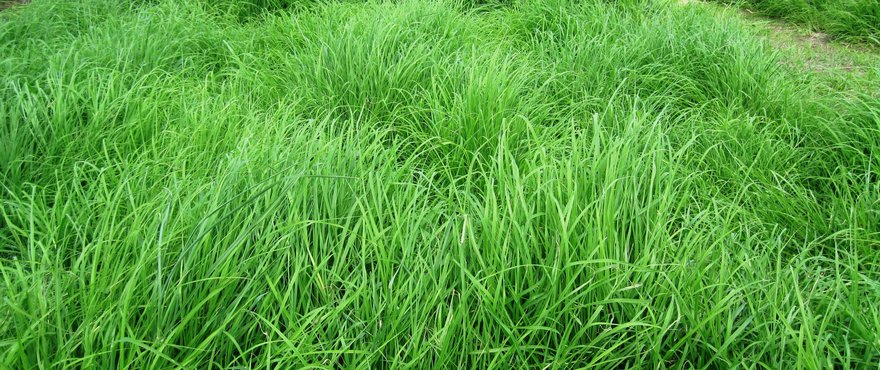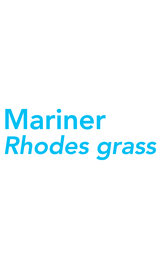Download a copy of the Mariner Rhodes Grass factsheet.
Mariner, a tetraploid Rhodes grass (Chloris gayana), is a new Samford type. Bred in Australia, this perennial variety was specifically selected for superior growth characteristics including increased production, persistence and greater forage quality over commercial Samford and Callide varieties. Leaf blades are large, with multiple tillering characteristics producing a high leaf to stem ratio. Palatability of this variety remains high, even when mature. The multiple tillering characteristics of Mariner produces a high leaf to stem ratio, which provides more consumable dry matter than other tetraploid Rhodes grass varieties. Maturity evenness of this variety provides higher protein feed late in the season. Mariner demonstrates exceptional recovery after grazing or cutting. Later flowering than other Samford or Callide Rhodes grass types provides Mariner the ability to maintain feed quality longer and out yield similar varieties in the market place.
Uses
Mariner Rhodes grass is an excellent option for high input, intensive grazing or hay cutting operations. The stoloniferous ability of Rhodes grass makes it ideal for land reclamation and erosion control.
Suggested Sowing Rates (AgriCote coated seed)
Marginal Dryland: 4−6Kg/Ha
Ideal Dryland: 8−12Kg/Ha
Irrigated: 15−20Kg/Ha
Variety Management / Agronomy
Mariner is well suited to tropical, sub-tropical and warm coastal temperate regions. Rhodes grass tolerates a wide range of soils. Tetraploid Rhodes grass performs and persists best on soils of higher fertility and will respond exceptionally to higher input (fertiliser/irrigation) applications and/or management for intensive production systems. It can however be hard to establish on heavy cracking clays.
Compatibility (with other species)
Mariner Rhodes grass performs well in tropical mixes and is compatible with a variety of pasture species. Grasses include lower growing Panic species (Gatton and Green), Brachiaria, Setaria and Bluegrasses. Mariner combines well with legumes such as Burgundy Bean, Siratro, Desmodium, Butterfly Pea, Centro, Glycine, Coastal Stylo, Desmanthus, and Lucerne. Persistence of these legumes over time will be dependent on grazing management as many of these legumes may be less tolerant of grazing or have different management requirements.
Growth Habit
Mariner Rhodes grass has a dense, tufted, leafy growth habit with finer leaf and stems compared to Samford or Callide. The variety is strongly stoloniferous, whose aggressive runners provide good soil cover for weed suppression and erosion control. This stoloniferous characteristic aids in strong establishment, long term persistence and makes this species ideal for land reclamation. Mariner Rhodes grass has the ability to dispose excess salt on the basal growth region of the plant, providing salt tolerance abilities. Mariner Rhodes being a tetraploid, is sensitive to day length and flowering occurs in response to shortening day length. Flushes of flowering occur when day length falls below 12 hours, resulting in an intense flowering event at this time.
Establishment
Seed can be drilled or broadcast and being a small seed, should be planted ideally at 5mm and no more than 1cm deep. Seed to soil contact is important. The use of press wheels or, on non-hard setting soils rolling after sowing, will greatly improve germination and establishment. Care should be taken not to plant in the hottest summer weather without adequate moisture – the seed must maintain close contact with wet soil for about 3-4 days to establish a seedling. The fluffier nature of tetraploid Rhodes grass tends to cause the bare seed to ‘ball’ or bridge when planting. The pelleted nature of coated seed allows the seed to flow more readily. The use of AgriCote coated seed will greatly improve the establishment success of Mariner.
Persistence
Mariner demonstrates greater persistence than Samford or Callide. Mariner Rhodes grass can be used as a permanent pasture or a short to medium term pasture ley. Long term persistence is dependent on adequate nutrition, moisture, warm temperatures and ideal grazing management. Poor tolerance to shade.
Management
The success of a pasture will depend on grazing management in the first season. Do not graze until follow-up rain post planting allows seedlings to develop a strong root system and set some seed, then graze lightly. Rotational grazing practices are preferable to continuous stocking to ensure long term persistence. Tetraploid Rhodes grasses such as Mariner have a higher moisture requirement. Mariner is better suited to higher rainfall districts, coastal regions and under irrigation. Mariner Rhodes grass will not tolerate heavy cracking clay soils, finding these type of soils difficult to establish and persist in.
Fertiliser / Nutrition
Rhodes grass can survive and tolerate infertile soil, however will become unproductive and persistence will be greatly reduced, particularly if grazed or cut frequently. The use of AgriCote coated seed ensures essential macro and micronutrients are immediately available to the seedling.
Responds to phosphorus in poorer soils. N and P fertiliser is recommended at sowing, banded away from the seed. A maintenance fertiliser program is recommended to replace nutrient removed by grazing or hay cutting over time, particularly at the high stocking densities which can be sustained by such grasses. Split applications of 50−100Kg/ Ha N are used often. The use of a soil test will form the foundation of a suitable fertiliser program. Production declines without a vigorous legume or the use of nitrogen fertiliser.
Toxicity
No record of toxicity in any livestock species. The low levels of oxalate in Mariner makes it an ideal species for horse pastures.
Plant Breeders Rights (PBR): This variety is registered under Plant Breeders Rights (PBR) in Australia. Unauthorised commercial propagation or any sale, conditioning, export, import or stocking of propagating material is an infringement under the Plant Breeders Rights Act (1994). Any breach of this legislation will leave the grower liable for prosecution.
Disclaimer: The information presented in this brochure is from official and other sources and is considered to be reliable. It is provided in good faith and every care has been taken to ensure its accuracy. Barenbrug does not accept any responsibility for the consequences that may arise from the acceptance of recommendations or the suggestions made.



